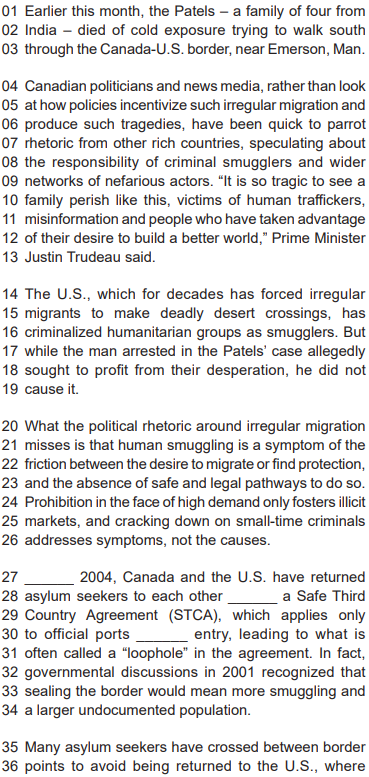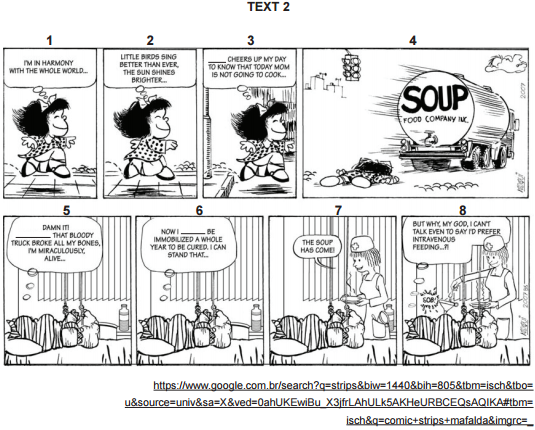Questões de Vestibular
Sobre comparativo e superlativo de adjetivos | comparative and superlative em inglês
Foram encontradas 32 questões


( ) The last sentence in Text 1 (lines 44 to 46) presents two examples of adjectives in the comparative degree. ( ) “avoid being returned” (line 36) is about an action that will/would happen while “remember being arrested” is about an action that has already happened. ( ) The two instances of the word “such” (lines 05 and 06) have the same idea as “such” in “I cannot imagine anyone living on such a small salary”.
The alternative that presents the correct top-down sequence of answers to the sentences above is


Backpacs” (title) - a large bag carried on the back.
“strap” (l. 2) - a strip of leather, cloth or other flexible material.
“lugging” (l. 5) - carrying something with great effort. “prof” (l. 8) - professor.
“sprains” (l. 18) - injuries.
“strains” (l. 18) - severe demands on physical strengh.
Leia o texto e responda à questão.

Adapted from: https://www.dailymail.co.uk/sciencetech/article-7399879/European-capital-cities-dominate-list-worlds-FASTEST-public-transport-systems.html
Last access: August, 29, 2019.
Fire Devastates Brazil's Oldest Science Museum
The overnight inferno likely claimed fossils, cultural artifacts, and more irreplaceable collections amassed over 200 years.
By Michael Greshko ______________________________________
PUBLISHED September 6, 2018
Major pieces of Brazil's scientific and cultural heritage went up in smoke on September 2, as a devastating fire ripped through much of Rio de Janeiro's Museu Nacional, or National Museum. Founded in 1818, the museum is Brazil's oldest scientific institution and one of the largest and most renowned museums in Latin America, amassing a collection of some 20 million scientifically and culturally invaluable artifacts.
The Museu Nacional's holdings include Luzia, an 11,500-year-old skull considered one of South America's oldest human fossils, as well as the bones of uniquely Brazilian creatures such as the long-necked dinosaur Maxakalisaurus. Because of the auction tastes of Brazil's 19th-century emperors, the Museu Nacional also ended up with Latin America's oldest collection of Egyptian mummies and artifacts.
Even the building holds historical importance: It housed the exiled Portuguese royal family from 1808 to 1821, after they fled to Rio de Janeiro in 1807 to escape Napoleon. The complex also served as the palace for Brazil's post-independence emperors until 1889, before the museum collections were transferred there in 1902. In an September 5 email, Museu Nacional curator Débora Pires wrote that the entomology and arachnology collections were completely destroyed, as was most of the mollusk collection. However, technicians had braved the fire to save 80 percent of the mollusk holotypes—the specimens that formally serve as the global references for a given species. The museum's vertebrate specimens, herbarium, and library were housed separately and survived the fire.
(…)
An Irreplaceable Loss
It's not yet clear how the fire started, but it did begin after the museum was closed to the public, and no injuries have yet been reported. Firefighters worked through the night to douse the burnt-out shell of the main building, but it seems the blaze has already seared a gaping hole in many scientists' careers.
“The importance of the collections that were lost couldn't be overstated,” says Luiz Rocha, a Brazilian ichthyologist now at the California Academy of Sciences who has visited the Museu Nacional several times to study its collections. “They were unique as it gets: Many of them were irreplaceable, there's no way to put a monetary value on it.”
“In terms of [my] life-long research agenda, I'm pretty much lost,” says Marcus Guidoti, a Brazilian entomologist finishing up his Ph.D. in a program co-run by Brazil's Federal University of Rio Grande do Sul.
Guidoti studies lace bugs, an insect family with more than 2,000 species worldwide. The Museu Nacional held one of the world's largest lace bug collections, but the fire likely destroyed it and the rest of the museum's five million arthropod specimens. “Those type specimens can't be replaced, and they are crucial to understand the species,” he says by text message. “If I was willing to keep working on this family in this region of the globe, this was definitely a big hit.”
Paleontologist Dimila Mothé, a postdoctoral researcher at the Federal University of the State of Rio de Janeiro, adds that the blows to science extend beyond the collections themselves. “It's not only the cultural history, the natural history, but all the theses and research developed there,” she says. “Most of the laboratories there were lost, too, and the research of several professors. I'm not sure you can say the impact of what was lost.”
Brazil’s indigenous knowledge also has suffered. The Museu Nacional housed world-renowned collections of indigenous objects, as well as many audio recordings of indigenous languages from all over Brazil. Some of these recordings, now lost, were of languages that are no longer spoken.
“I have no words to say how horrible this is,” says Brazilian anthropologist Mariana Françozo, an expert on South American indigenous objects at Leiden University. “The indigenous collections are a tremendous loss … we can no longer study them, we can no longer understand what our ancestors did. It’s heartbreaking.”
On Monday, The Brazilian publication G1 Rio reported that ashes of burned documents—some still flecked in notes or illustrations—have rained down from the sky more than a mile away from the Museu Nacional, thrown aloft by the inferno.
(…)
Editor's Note: This story was updated on September 6, 2018, with new details about which artifacts survived the fire.
Taken from:
https://www.nationalgeographic.com/science/2018/09/news-museu-nacional-fire-rio-de-janeiro-natural-history/. Access: 11 dez. 2018.

Pseudoscientific claims that music helps plants grow have been made for decades, despite evidence that is shaky at best. Yet new research suggests some flora may be capable of sensing sounds, such as the gurgle of water through a pipe or the buzzing of insects.
In a recent study, Monica Gagliano, an evolutionary biologist at the University of Western Australia, and her colleagues placed pea seedlings in pots shaped like an upside-down Y. One arm of each pot was placed in either a tray of water or a coiled plastic tube through which water flowed; the other arm had dry soil. The roots grew toward the arm of the pipe with the fluid, regardless of whether it was easily accessible or hidden inside the tubing. “They just knew the water was there, even if the only thing to detect was the sound of it flowing inside the pipe,” Gagliano says. Yet when the seedlings were given a choice between the water tube and some moistened soil, their roots favored the latter. She hypothesizes that these plants use sound waves to detect water at a distance but follow moisture gradients to home in on their target when it is closer.
The research, reported earlier this year in Oecologia, is not the first to suggest flora can detect and interpret sounds. A 2014 study showed the rock cress Arabidopsis can distinguish between caterpillar chewing sounds and wind vibrations – the plant produced more chemical toxins after “hearing” a recording of feeding insects. “We tend to underestimate plants because their responses are usually less visible to us. But leaves turn out to be extremely sensitive vibration detectors,” says lead study author Heidi M. Appel, an environmental scientist now at the University of Toledo.
INSTRUÇÃO: a questão deve ser respondida com base no texto a seguir.


Adapted from:< http://www.psychologicalscience.org/index.php/news/releases/consumerism-and-its-antisocial-effects-can-beturned-onor-off.html> and < http://grist.org/living/consumerism-plays-a-huge-role-in-climate-change/>Acessed on September 1st, 2016.

THE HONEYBEE has... Disponível em: <www.bbc.co.uk/news/scienceenvironment-34749846>. Acesso em: 21 set. 2016.
Question: Is there anything I can do to train my body to need less sleep?
Karen Weintraub
June 17, 2016

Many people think they can teach themselves to need less sleep, but they’re wrong, said Dr. Sigrid Veasey, a professor at the Center for Sleep and Circadian Neurobiology at the University of Pennsylvania’s Perelman School of Medicine. We might feel that we’re getting by fine on less sleep, but we’re deluding ourselves, Dr. Veasey said, largely because lack of sleep skews our self-awareness. “The more you deprive yourself of sleep over long periods of time, the less accurate you are of judging your own sleep perception,” she said.
Multiple studies have shown that people don’t functionally adapt to less sleep than their bodies need. There is a range of normal sleep times, with most healthy adults naturally needing seven to nine hours of sleep per night, according to the National Sleep Foundation. Those over 65 need about seven to eight hours, on average, while teenagers need eight to 10 hours, and school-age children nine to 11 hours. People’s performance continues to be poor while they are sleep deprived, Dr. Veasey said.
Health issues like pain, sleep apnea or autoimmune disease can increase people’s need for sleep, said Andrea Meredith, a neuroscientist at the University of Maryland School of Medicine. A misalignment of the clock that governs our sleep-wake cycle can also drive up the need for sleep, Dr. Meredith said. The brain’s clock can get misaligned by being stimulated at the wrong time of day, she said, such as from caffeine in the afternoon or evening, digital screen use too close to bedtime, or even exercise at a time of day when the body wants to be winding down.
(http://well.blogs.nytimes.com. Adaptado.)
Read the text and answer the question.
Life stress may lead to cognitive developmental delays in children
According to a new study, children living in harsh or unstable environments are more likely to experience learning and cognitive delays by age 4.
Researchers examined the cortisol levels and cognitive delays of 201 children from low-income families in the northeastern United States. It was found that those kids with higher levels of cortisol experienced harsh or insensitive caregiving.
"We discovered that exposure to specific forms of family adversity when children were 2 years old predicted their cortisol profile, which in turn was linked with notable differences in children´s cognitive functioning at age 4," the researchers say.
Disponível em: <http://www.shortnews.com/start.cfm?id=100733> . Acesso em: 16/06/15.
According to the research, we can state that:
I. Children who are more stressed may have cognitive delay.
II. Children who are stresser may have developmental delays.
III. Children from more rich families were evaluated in this research.
IV. Children from richer families were evaluated in this research.
V. Children from poorer families were evaluated in this research.
Excerpt 01: "Protesters say the poorest are being short-changed while the government spends the large bills on new stadiums and glitzy infrastructure for the soccer competition Brazil is hosting next year and the Olympic Games coming in 2016."
I – There is an example of passive voice.
II – There is an example of comparative of adjectives.
III – The noun phrase “glitzy infrastructure for the soccer competition” is formed by a determiner, a pre modifier, a noun and a post modifier.
IV - “while” indicates simultaneous actions.
1With the increasing popularity of wireless devices like smartphones — devices that can move lots of data very quickly — users have access to their social networks 24 hours a day. Most social networking sites have developed applications for your mobile phone, so logging on is always convenient. Social networks also tap into our human desire to stay connected with others. Besides, the rush of nostalgia as you connect with your former grade-school classmate on Facebook can be quite heady and exciting.
2But what's the main reason we find these sites so addictive? Plain old narcissism. We broadcast our personalities online whenever we publish a thought, photo, YouTube video or answer one of those “25 Things About Me" memes. We put that information out there so people will respond and connect to us. And being part of a social network is sort of like having your own entourage that follows you everywhere, commenting on and applauding everything you do. It's very seductive.
3In 2008, researchers at the University of Georgia studied the correlation between narcissism and Facebook users. Unsurprisingly, they found that the more “friends" and wall posts a user had, the more narcissistic he or she was. They noted that narcissistic people use Facebook in a selfpromoting way, rather than in a connective way. It may be an obvious theory, but it also suggests that social networks bring out the narcissist in all of us.
4Social networks are also a voyeuristic experience for many users. Following exchanges on Twitter or posts on Facebook and MySpace are akin to eavesdropping on someone else's conversation. It's entertaining and allows you to feel like a “fly on the wall" in someone else's life.
5Social networking sites also publicly list your “friends" or “followers" — giving you instant status. How many people do you know online who spend all their time trying to get more friends, more followers, more testimonials? We work hard in real life to elevate our statuses, make friends and search out boosters for our self-esteem. Online social networking provides this to us, and we don't even have to change out of our sweatshirts to get it.
(adapted from http://computer.howstuffworks.com/internet/socialnetworking/information/social-networking-sites-addictive2.htm)
Glossary
addictive: viciante; tap into: explorar/tirar proveito; broadcast: anunciar; entourage: comitiva/séquito; akin to eavesdropping: parecido com bisbilhotar; booster: aquilo que impulsiona; sweatshirts: camisetas
Brazil turns to drones to protect Amazon
By Joe Leahy in Alta Floresta, Mato Grosso. April 21,2014.
Brazilian municipalities are turning to drones as they prepare to implement a tough new law designed to save the Amazon from total deforestation.
Municipal authorities in the Amazon region, ...........1 ............. of which covers double the size of Scotland, are looking to use drones to map properties and monitor whether farmers and others are maintaining the minimum of forest cover required under the new forest code.
“With the acquisition of a drone, we would have a better result, we would have a panoramic view of how this process of recuperation is progressing," said Gercilene Meira, a specialist with the state environmental secretariat in the municipality of Alta Floresta, in Mato Grosso state. “We have done some tests using balloons but it was not sufficient."
Passed in 2012, Brazil's forest code was hailed as a breakthrough in the country's efforts to protect the Amazon while maintaining its emergence as an agricultural power. It is already one of ...........2 ............. exporters of sugar, coffee, soya beans and beef.
The law requires farmers in the Amazon to preserve up to 80 per cent of the forest on their land as well as protect springs and rivers. Those who violated previous restrictions on deforestation are required
to recuperate parts of the lost vegetation on their lands.
The need for the new law was highlighted last year, when deforestation of the Amazon increased for the first time in several years.
Adapted from Financial Times
Dark Deeds by Anne Marie Becker. Book 4, Mindhunters. Walking away from sexy Detective Diego Sandoval ................... one of ................... things security specialist Becca Haney ever had to do, but when he’s assigned to help keep her safe from a human trafficking ring and an admirer ................... only as “the Fan,”, he’s determined to stay by her side and learn about the woman behind the passion – scars and all.
USA TODAY





